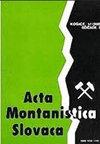The effect of different clay minerals on the flotation kinetics of chalcopyrite
IF 1.4
4区 地球科学
Q2 GEOSCIENCES, MULTIDISCIPLINARY
引用次数: 1
Abstract
This study investigated the effects of clay minerals (montmorillonite, illite, and kaolinite) on chalcopyrite recovery and flotation kinetic parameters. Classical first-order flotation kinetic model was applied as a function of froth height and amount of clay minerals to fit overall flotation results on chalcopyrite recovery against flotation time. Clay minerals enhanced chalcopyrite recovery by mechanical entrainment and slime coating of valuable chalcopyrite particles. Flotation tests have shown that the deleterious impact of clay minerals on the chalcopyrite flotation is enhanced as follows: montmorillonite>kaolinite>illite. Montmorillonite significantly raised viscosity and also considerably diminished chalcopyrite grade. Recovery and selectivity were lower for montmorillonite than kaolinite and illite. The adjunct of illite was of little effect on chalcopyrite flotation kinetics. The obtained flotation rate constants indicate that clay minerals are carried to the concentrate together with the chalcopyrite. The flotation rate constants increased with increasing the amount of all clay minerals. Slime minerals easily entered to concentrate by mechanical entrainment, and the inhibition effect of clay particles on chalcopyrite became more obvious with increasing flotation time. However, the negative effect of clay minerals is reduced with high froth height.不同粘土矿物对黄铜矿浮选动力学的影响
研究了粘土矿物(蒙脱石、伊利石和高岭石)对黄铜矿回收率和浮选动力学参数的影响。应用经典的一阶浮选动力学模型作为泡沫高度和粘土矿物量的函数,以拟合黄铜矿回收率随浮选时间的总体浮选结果。粘土矿物通过有价值的黄铜矿颗粒的机械夹带和黏液涂层提高了黄铜矿的回收率。浮选试验表明,粘土矿物对黄铜矿浮选的有害影响增强为:蒙脱石>高岭石>伊利石。蒙脱石显著提高了粘度,也显著降低了黄铜矿品位。蒙脱石的回收率和选择性低于高岭石和伊利石。伊利石助剂对黄铜矿浮选动力学影响不大。获得的浮选速率常数表明,粘土矿物与黄铜矿一起被带到精矿中。浮选速率常数随粘土矿物含量的增加而增加。泥质矿物很容易通过机械夹带进入精矿,随着浮选时间的增加,粘土颗粒对黄铜矿的抑制作用越来越明显。然而,粘土矿物的负面影响随着泡沫高度的增加而减少。
本文章由计算机程序翻译,如有差异,请以英文原文为准。
求助全文
约1分钟内获得全文
求助全文
来源期刊

Acta Montanistica Slovaca
地学-地球科学综合
CiteScore
3.60
自引率
12.50%
发文量
60
审稿时长
30 weeks
期刊介绍:
Acta Montanistica Slovaca publishes high quality articles on basic and applied research in the following fields:
geology and geological survey;
mining;
Earth resources;
underground engineering and geotechnics;
mining mechanization, mining transport, deep hole drilling;
ecotechnology and mineralurgy;
process control, automation and applied informatics in raw materials extraction, utilization and processing;
other similar fields.
Acta Montanistica Slovaca is the only scientific journal of this kind in Central, Eastern and South Eastern Europe.
The submitted manuscripts should contribute significantly to the international literature, even if the focus can be regional. Manuscripts should cite the extant and relevant international literature, should clearly state what the wider contribution is (e.g. a novel discovery, application of a new technique or methodology, application of an existing methodology to a new problem), and should discuss the importance of the work in the international context.
 求助内容:
求助内容: 应助结果提醒方式:
应助结果提醒方式:


